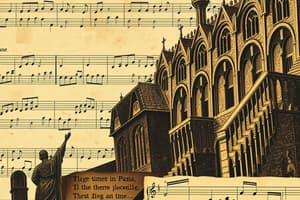Podcast
Questions and Answers
What is the primary characteristic of Gregorian Chant?
What is the primary characteristic of Gregorian Chant?
- Written in multiple languages
- Monophonic plainchant (correct)
- Strict rhythmic meter
- Polyphonic texture
Which term describes the musical notation used in Gregorian Chant?
Which term describes the musical notation used in Gregorian Chant?
- Neumes (correct)
- Tablature
- Choral score
- Staff notation
What themes did troubadour music primarily explore?
What themes did troubadour music primarily explore?
- Religious devotion
- Heroic battles
- Political satire
- Chivalry and courtly love (correct)
Who was responsible for making Gregorian Chant the approved music of the Catholic Church?
Who was responsible for making Gregorian Chant the approved music of the Catholic Church?
Which of the following best describes the role of minstrels in medieval society?
Which of the following best describes the role of minstrels in medieval society?
What distinguishes chansons from other types of medieval music?
What distinguishes chansons from other types of medieval music?
Which of the following best describes the characteristics of troubadour music?
Which of the following best describes the characteristics of troubadour music?
What is the geographical distinction between troubadours and trouveres?
What is the geographical distinction between troubadours and trouveres?
Flashcards are hidden until you start studying
Study Notes
The Medieval Period
- Known as the Middle Ages or "Dark Ages."
- Began with the fall of the Roman Empire around 500 AD.
- The Catholic Church emerged as the dominant institution.
- Music was predominantly religious during this era.
Musical Forms of the Medieval Period
- Sacred Music: Primarily focused on worship and included Gregorian Chant.
- Secular Music: Included Troubadour music, reflecting everyday life and themes.
Gregorian Chant
- Official music of the Roman Catholic Church for centuries.
- Also referred to as Plainsong or Plainchant.
- Named after Pope Gregory I, who endorsed its use.
- Monophonic nature, utilizing a single melodic line.
- Neumes represent the earliest form of musical notation.
Characteristics of Gregorian Chants
- Monophonic: Sole melodic line without harmony.
- Free meter: Flexible rhythm, not strictly metric.
- Based on Latin liturgy: Lyrics were religious texts.
- Utilization of Neume notation for recording melodies.
Troubadour Music
- Captured various aspects of medieval life through songs and dances.
- Common themes included chivalry and courtly love.
- Originated in Southern France, sung in French.
Minstrels
- Mini-servants who traveled between courts and towns.
- Entertained audiences with songs, news, and gossip.
- Jongleurs/Jongleuresse: Entertainers who performed various acts, including juggling, dancing, and animal tricks.
Troubadours and Trouvères
- Troubadours: Southern French poet-musicians.
- Trouvères: Northern French counterparts, both emphasizing poetry and music.
- Flourished in European courts, contributing to cultural richness.
Minnesingers
- Performers who sang about themes of courtly love.
Characteristics of Troubadour Music
- Typically monophonic in texture.
- Sometimes accompanied by musical instruments.
- Lyric content focused on themes of chivalry and romance.
- Written in the French language.
Famous Composer of the Medieval Period
- Adam de la Halle: French trouvére active from 1237 to 1288.
- Known as "Adam le Bossu" (Adam the Hunchback).
- One of the earliest secular composers, contributing chansons and poetic debates.
Notable Works of Adam de la Halle
- "Le Jeu de Robin et de Marion": A notable theatrical work.
- "La Chanson du roi de Sicile": Another recognized composition.
Studying That Suits You
Use AI to generate personalized quizzes and flashcards to suit your learning preferences.




